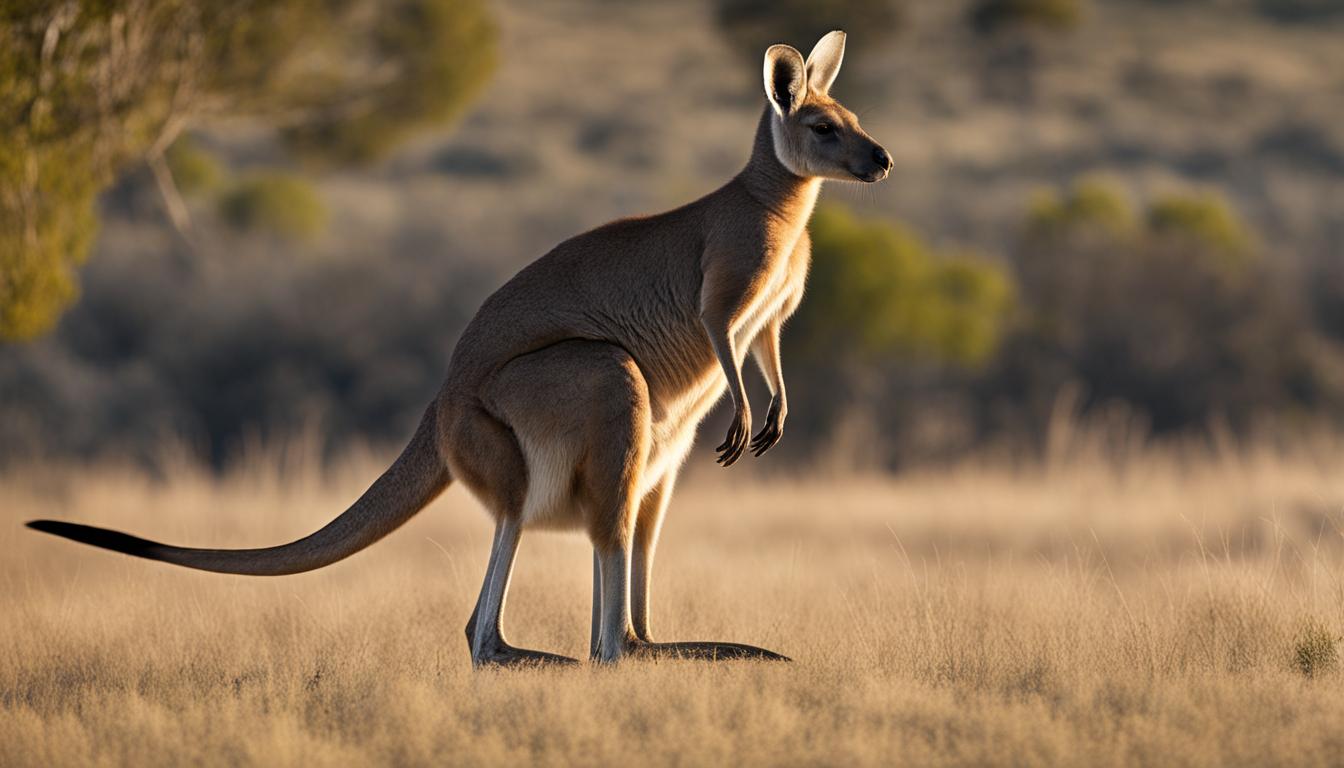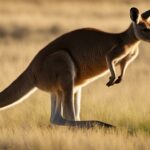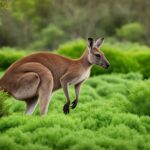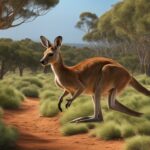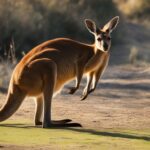Welcome to our fascinating exploration of the anatomy and body structure of kangaroos! These incredible creatures have a unique physique that allows them to thrive in the Australian wilds. From their skeletal system to their muscular adaptations, kangaroos are truly remarkable. Let’s dive into the details of their body structure and understand what makes them so special.
When we talk about the body structure of kangaroos, we are referring to their skeletal system, muscular system, and specialized adaptations. Their skeleton and muscles work together to enable their distinctive hopping motion and provide balance and stability in their environment.
Stay tuned as we explore the intricate details of the kangaroo’s skeletal system, muscular system, specialized adaptations, their biology, and much more. Get ready to be amazed by the wonders of nature!
The Skeletal System of a Kangaroo
Kangaroos have a unique skeletal system that is perfectly adapted for their hopping locomotion. Their hind legs, which are elongated and powerful, provide the primary source of propulsion for their jumps. The bones in their hind feet, known as the metatarsals, are elongated and fused together to form a strong and flexible structure. This allows kangaroos to absorb the impact of landing after a hop, reducing stress on their joints and preventing injury.
The front limbs of kangaroos, on the other hand, are relatively short and are primarily used for balance and support. The bones in their forelimbs, including the radius and ulna, are sturdy but not as developed as their hind limb bones. This skeletal structure enables kangaroos to maintain their balance while hopping and maneuvering through their environment.
The spine of a kangaroo is another remarkable feature of their skeletal system. It is designed to absorb the powerful forces generated during hopping. The vertebrae in their spine are elongated and have specialized shock-absorbing discs between them. This allows kangaroos to land smoothly and efficiently, reducing the impact on their body and preventing injury.
| Bone Structure | Function |
|---|---|
| Hind Limb Bones | Provide propulsion for hopping |
| Hind Feet Bones | Absorb impact and provide stability |
| Forelimb Bones | Assist in balance and support |
| Spinal Vertebrae | Absorb shock during landing |
The skeletal adaptations of kangaroos highlight their remarkable ability to move efficiently and survive in their environment. Their specialized bones and joint structures enable them to carry out their unique hopping locomotion, making them one of the most fascinating animals in the Australian wilds.
References:
- “Anatomy of a Kangaroo.” Nature’s Path. Accessed 15 April 2021. https://www.naturespath.com/en-us/blog/anatomy-of-a-kangaroo/
- “Kangaroo Anatomy.” Discover Wildlife. Accessed 15 April 2021. https://www.discoverwildlife.com/animal-facts/mammals/kangaroo-anatomy/
The Muscular System of a Kangaroo
The muscular system of a kangaroo plays a crucial role in their unique form of locomotion. Their powerful muscles, particularly in the hind legs, provide the force needed for hopping, which is the primary mode of transportation for kangaroos. These muscles, including the thigh and calf muscles, are well-developed and allow for the incredible speed and agility that kangaroos are known for.
In addition to their leg muscles, kangaroos also rely on their tail muscles for balance and stability. The tail serves as a fifth limb, providing support and helping them maintain their posture while hopping. The muscles in the tail are strong and flexible, enabling kangaroos to pivot and change direction quickly and efficiently.
Another essential set of muscles in a kangaroo’s body is the abdominal muscles. These muscles are well-developed and provide support for the kangaroo’s internal organs. They also play a role in maintaining proper posture during movement. With the combination of powerful hind leg muscles, tail muscles, and strong abdominal muscles, kangaroos are well-equipped for their unique locomotion and the challenges of their environment.
The Role of Muscles in Kangaroo Locomotion
The muscular system of a kangaroo is intricately connected to their ability to move and survive in the wild. The unique adaptation of hopping requires specialized muscles that can generate the necessary force and power. Kangaroos have evolved over time to develop highly efficient muscles in their legs, tail, and abdomen, allowing them to thrive in their natural habitat.
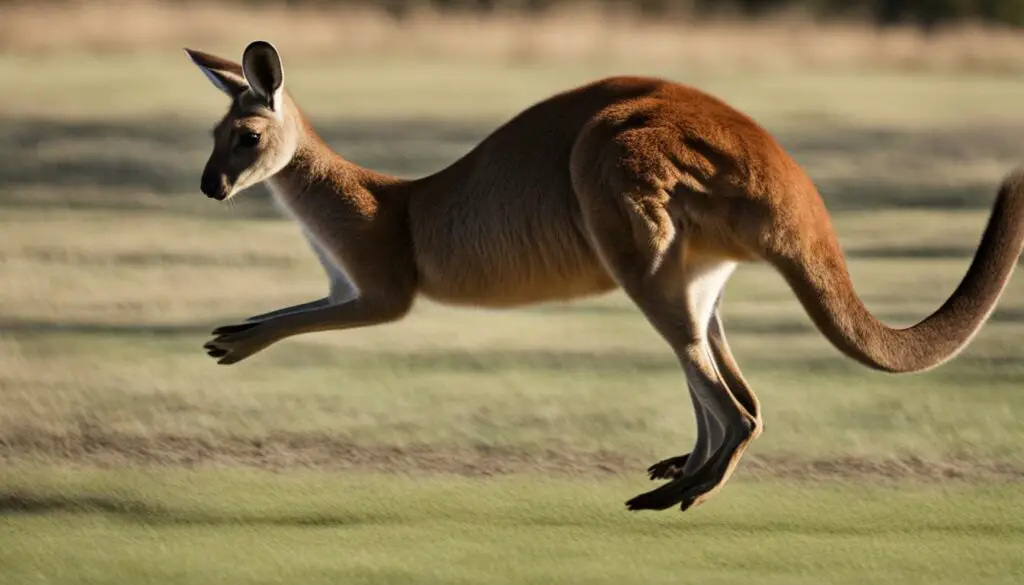
| Muscle Group | Function |
|---|---|
| Hind Leg Muscles | Generate force for hopping |
| Tail Muscles | Aid in balance and stability |
| Abdominal Muscles | Support internal organs and maintain posture |
The table above summarizes the main muscle groups in a kangaroo’s body and their respective functions. These muscles work together to enable kangaroos to move with efficiency, agility, and balance. This unique musculoskeletal system is a testament to the remarkable adaptations of these fascinating creatures.
Specialized Adaptations of Kangaroos
Kangaroos have evolved a range of specialized adaptations that have enabled them to thrive in their unique habitat. These remarkable adaptations contribute to their survival and success in the Australian wilds.
Pouch for Rearing Young
One of the most distinctive adaptations of female kangaroos is their pouch, known as a marsupium. The pouch is located on their abdomen and provides a safe and nurturing environment for their young, called joeys. After giving birth, the mother carries her tiny, undeveloped joey in her pouch, where it attaches to a teat and continues to grow and develop for several months. This adaptation allows the mother to provide constant care and protection to her offspring, ensuring their survival in the harsh surroundings.
Large, Muscular Tail
Kangaroos possess a large and muscular tail that serves multiple functions. Not only does the tail aid in balance and stability, acting as a fifth limb, but it also helps propel the kangaroo forward during its powerful hops. The tail muscles are essential for maintaining stability and controlling movement, especially when maneuvering through challenging terrain. This unique adaptation allows kangaroos to navigate their environment with exceptional agility and efficiency.
Keen Eyesight and Excellent Hearing
Kangaroos have adapted to rely on their senses for detecting predators and navigating their surroundings. Their large, forward-facing eyes provide excellent vision, enabling them to spot potential threats from afar. Additionally, kangaroos have highly developed hearing, allowing them to detect even the slightest sounds in their environment. These adaptations give them a heightened awareness of their surroundings, increasing their chances of survival in the wild.
| Adaptation | Description |
|---|---|
| Pouch for Rearing Young | The female kangaroo has a pouch on her abdomen where she can carry and protect her undeveloped young, known as joeys. |
| Large, Muscular Tail | Kangaroos have a powerful tail that acts as a fifth limb, aiding in balance, stability, and propulsion during hopping. |
| Keen Eyesight and Excellent Hearing | Kangaroos have sharp vision and acute hearing, allowing them to detect potential threats and navigate their environment. |
These specialized adaptations, such as the pouch, muscular tail, and heightened senses, are just a few examples of how kangaroos have evolved to thrive in their unique environment. Through these remarkable adaptations, kangaroos have become well-suited to the challenges they face and continue to be an iconic symbol of the Australian wildlife.
The Biology of Kangaroos
Kangaroos have a unique biology that encompasses various aspects of their life cycle and dietary preferences. Understanding these biological factors provides valuable insights into the fascinating world of kangaroos.
Kangaroo Life Cycle
The life cycle of a kangaroo involves distinct stages that contribute to their survival in the harsh Australian environment. Female kangaroos have a specialized pouch where they carry and nurture their young, known as joeys. The development of joeys takes place inside the pouch, where they attach to their mother’s teat for nourishment. This attachment ensures their growth and protection during the vulnerable stages of their lives.
As joeys mature, they gradually emerge from the pouch and begin to explore their surroundings while still seeking their mother’s guidance and protection. Eventually, they become independent and venture out on their own.
Kangaroo Diet
Kangaroos are herbivores with a diet primarily consisting of grass, leaves, and other vegetation. Their specialized teeth, including sharp incisors and strong molars, enable them to efficiently chew and process plant material. Additionally, kangaroos have a unique digestive system that allows them to extract maximum nutrients from their plant-based diet.
Their diet is essential not only for their survival but also for maintaining the delicate balance of the Australian ecosystem. By grazing on vegetation, kangaroos help control plant growth and prevent overgrazing in certain areas. Their feeding habits play a vital role in shaping the landscape and influencing the distribution of plant species.
| Kangaroo Diet | Description |
|---|---|
| Grass | Main component of their diet, provides essential nutrients |
| Leaves | Additional source of nutrients, consumed when available |
| Other vegetation | Includes shrubs, herbs, fruits, and tree bark, consumed based on availability and dietary needs |
Summary
The biology of kangaroos encompasses their life cycle, which involves the nurturing of joeys in specialized pouches and their eventual independence. Their herbivorous diet of grass, leaves, and other vegetation plays a crucial role not only in their survival but also in shaping the Australian ecosystem. Kangaroos have adapted to their environment through their unique biology, enabling them to thrive in the diverse and challenging landscapes of Australia.
Conclusion
The anatomy and body structure of kangaroos are fascinating and play a crucial role in their adaptations and biology. These unique creatures have a skeletal system that supports their large bodies and enables their distinctive hopping motion. Their elongated hind legs and specialized bones in their feet provide the power and stability needed for efficient movement.
Kangaroos also have a muscular system that is well-suited for their agile locomotion. The powerful muscles in their hind legs, particularly the thigh and calf muscles, are responsible for their impressive hopping ability. Additionally, their tail muscles contribute to balance and stability, making it a fifth limb. The strong abdominal muscles support their internal organs and help maintain their posture.
Along with their remarkable body structure, kangaroos possess several specialized adaptations that allow them to thrive in the Australian wilds. The pouch in female kangaroos is a notable adaptation, providing a safe space for their young to develop and grow. Their large, muscular tail serves as an additional means of balance and stability during movement. With keen eyesight and excellent hearing, kangaroos can detect predators and navigate their surroundings effectively.
Understanding the body structure, adaptations, and biology of kangaroos provides insights into their remarkable physical abilities and their ability to survive in their environment. From their skeletal and muscular systems to their unique adaptations, every aspect of their biology is finely tuned for their Australian habitat. Marvel at the wonders of kangaroo body structure and appreciate the incredible adaptations that have allowed them to flourish for centuries.
How does the anatomy of a kangaroo support the function of its pouch?
The anatomy of a kangaroo supports the function of its pouch in various ways. The strong, elastic muscles and skin surround the pouch, providing the necessary support for carrying and protecting the joey. Additionally, the position of the pouch allows the kangaroo to nurse and care for its young while on the move.
FAQ
What is the anatomy and body structure of a kangaroo?
Kangaroos have a unique body structure that includes specialized skeletal and muscular features. Their skeletal system supports their large bodies and allows for their distinctive hopping motion, while their muscular system provides the force needed for hopping and balance.
How does the skeletal system of a kangaroo contribute to their locomotion?
The skeletal system of a kangaroo includes elongated and powerful hind legs, specialized bones in their feet for hopping, and a spine designed to absorb the impact of landing after a hop. These features enable kangaroos to hop efficiently and move with stability.
What role do the muscles play in a kangaroo’s locomotion?
The muscular system of a kangaroo includes powerful muscles in their hind legs that provide the force for hopping, muscles in their tail for balance and stability, and well-developed abdominal muscles for support and posture maintenance.
What are some specialized adaptations of kangaroos?
Kangaroos have a pouch in females where they carry and protect their young, a large, muscular tail that serves as a fifth limb for balance and stability, and keen eyesight and excellent hearing to detect predators and navigate their surroundings.
What is the biology of kangaroos?
Female kangaroos have a pouch where they raise their young, and the development of their joeys takes place inside the pouch. Kangaroos are herbivores, feeding on grass, leaves, and other vegetation, and they have specialized teeth and a unique digestive system to process their plant-based diet efficiently.

